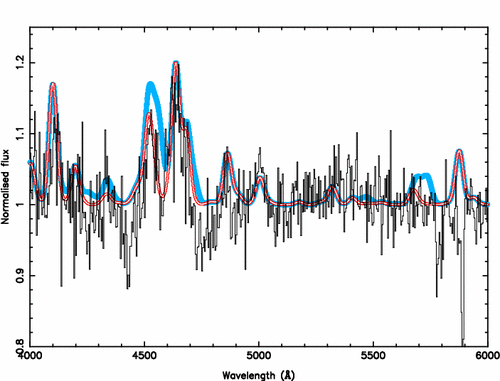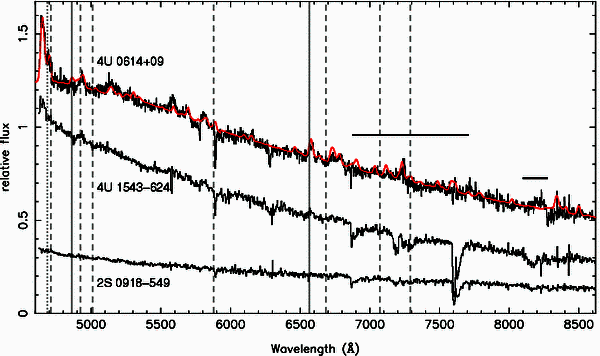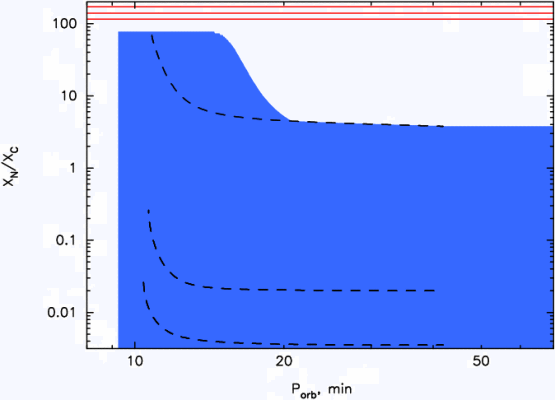Double white dwarfs
Common-envelope
evolution
AM CVn stars
Ultra-compact X-ray
binaries
Black hole binaries
SN Ia progenitors
Surveys
Gravitational waves
LISA wiki (verification
binaries)
Publications
Preprints
My thesis
Ultra-compact X-ray binaries
Ultra-compact X-ray binaries are very similar binaries to AM CVn systems, but with a neutron star or black hole accretor. See here for a discussion of their formation. Ultra-compact X-ray binaries are mostly studied with X-ray detectors, because they are rather faint in the optical band. We obtained optical spectra with the VLT and Gemini-North.
We have now collected optical spectra of seven UCXBs. Only one candidate (4U 1556-60) turned out not to be an UCXB. The chemical composition of the donor stars in the seven observed UCXBs turned out to be C/O in three cases (plus one possible case), while one system (XB 1916-05) has a helium rich donor. Of two systems the composition of the donor is unclear. See Nelemans, Jonker & Steeghs, 2006, MNRAS in press for more details.

Normalized optical spectrum of the known UCXB XB 1916-05 taken with the ESO Very Large Telescope, showing broad emission features. We identified these as helium, making this the first optical spectrum of a helios rich donor in an ultra-compact X-ray binary. A 30 kK LTE model consisting of pure helium plus nitrogen (thin red/white line) and a model including heavier elements at solar composition (thick light blue line) are shown for comparison. From Nelemans, Jonker & Steeghs, 2006, MNRAS in press
Earlier we took spectra for three objects which were suggested to be
ultra-compact X-ray binaries based on their X-ray spectrum. Our
optical spectra confirm their ultra-compact nature, as in the spectra
only emission lines from carbon and oxygen are visible, which means
the donor star in these systems is a carbon-oxygen white dwarf. For
the full text of the paper, click here.

Optical spectra of 4U 0614+09, 4U 1543-624 and 2S 0918-549. The red line is a simple LTE model which we used to identify the emission lines as lines of carbon and oxygen, confirming their ultra-compact nature. From Nelemans et al. 2004a.
Distinguising the donors by their abundance
The different formation channels that can lead to UCXBs stars can all lead to objects with similar periods and mass-transfer rates. Therefore, it has been difficult to determine which channels actually form the observed systems.
We studied the detailed chemical abundance of the material transferred from the donor star to the accreting white dwarf for the different formation channels and found that the N/C ratio is the best diagnostic, as helium white dwarf donors have high ratios (greater than 100), while helium star donors have ratios below about 80. Carbon-oxygen white dwarfs have no N at all, and remnants from evolved main-sequence donors typically still show some hydrogen. See Nelemans et al. 2009 for more details.
